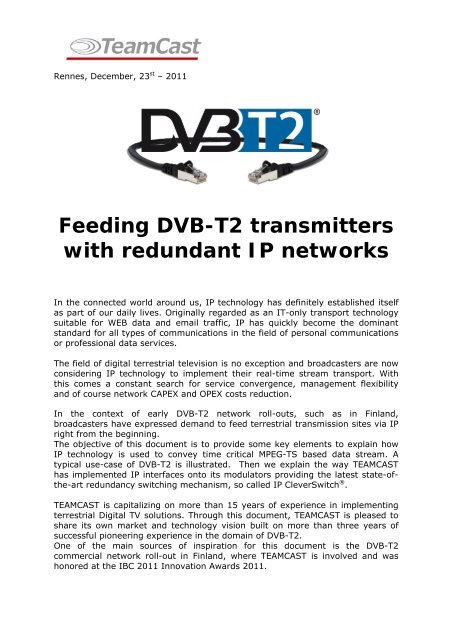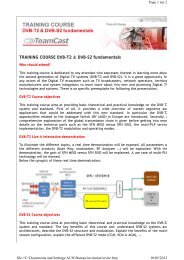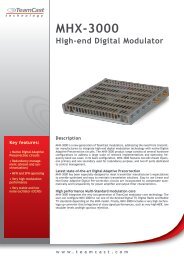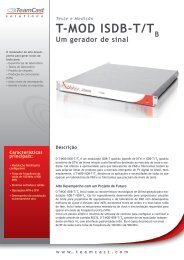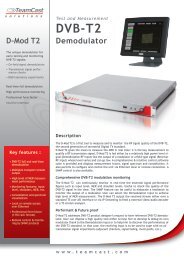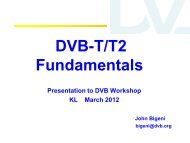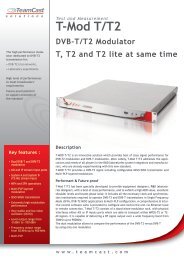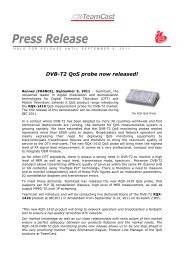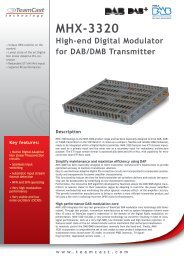IP feeding of DVB-T2 transmitters - Teamcast
IP feeding of DVB-T2 transmitters - Teamcast
IP feeding of DVB-T2 transmitters - Teamcast
Create successful ePaper yourself
Turn your PDF publications into a flip-book with our unique Google optimized e-Paper software.
Rennes, December, 23 st – 2011Feeding <strong>DVB</strong>-<strong>T2</strong> <strong>transmitters</strong>with redundant <strong>IP</strong> networksIn the connected world around us, <strong>IP</strong> technology has definitely established itselfas part <strong>of</strong> our daily lives. Originally regarded as an IT-only transport technologysuitable for WEB data and email traffic, <strong>IP</strong> has quickly become the dominantstandard for all types <strong>of</strong> communications in the field <strong>of</strong> personal communicationsor pr<strong>of</strong>essional data services.The field <strong>of</strong> digital terrestrial television is no exception and broadcasters are nowconsidering <strong>IP</strong> technology to implement their real-time stream transport. Withthis comes a constant search for service convergence, management flexibilityand <strong>of</strong> course network CAPEX and OPEX costs reduction.In the context <strong>of</strong> early <strong>DVB</strong>-<strong>T2</strong> network roll-outs, such as in Finland,broadcasters have expressed demand to feed terrestrial transmission sites via <strong>IP</strong>right from the beginning.The objective <strong>of</strong> this document is to provide some key elements to explain how<strong>IP</strong> technology is used to convey time critical MPEG-TS based data stream. Atypical use-case <strong>of</strong> <strong>DVB</strong>-<strong>T2</strong> is illustrated. Then we explain the way TEAMCASThas implemented <strong>IP</strong> interfaces onto its modulators providing the latest state-<strong>of</strong>the-artredundancy switching mechanism, so called <strong>IP</strong> CleverSwitch ® .TEAMCAST is capitalizing on more than 15 years <strong>of</strong> experience in implementingterrestrial Digital TV solutions. Through this document, TEAMCAST is pleased toshare its own market and technology vision built on more than three years <strong>of</strong>successful pioneering experience in the domain <strong>of</strong> <strong>DVB</strong>-<strong>T2</strong>.One <strong>of</strong> the main sources <strong>of</strong> inspiration for this document is the <strong>DVB</strong>-<strong>T2</strong>commercial network roll-out in Finland, where TEAMCAST is involved and washonored at the IBC 2011 Innovation Awards 2011.
1.1 IntroductionFor broadcasters and network operators worldwide, distribution network costsrepresent a burdensome business expense. During the last decade, <strong>IP</strong> technologyhas demonstrated its capability to transport video stream services with a highreliability <strong>of</strong> (QoS) quality <strong>of</strong> service performance. Consequently, TEAMCAST isparticipating in this progressive shift <strong>of</strong> existing broadcast network architecturetoward <strong>IP</strong> based solution.This transition to <strong>IP</strong> technology has progressively affected already completedDigital TV Network architecture, starting with contribution, multiplexing and nowthe transmitter sites. With the introduction <strong>of</strong> the second generation <strong>of</strong> terrestrialdigital TV (<strong>DVB</strong>-<strong>T2</strong>) and it’s successful adoption worldwide (8 countries havedeployed <strong>DVB</strong>-<strong>T2</strong> commercial services and more than 40 countries have adoptedthis standard worldwide since its introduction in 2009), <strong>feeding</strong> transmitter siteswith <strong>IP</strong> is a core requirement in the market place world-wide.For years, TEAMCAST has been the preferred choice <strong>of</strong> many transmittermanufacturers to provide best <strong>of</strong> class digital modulators supporting ASI inputswith redundancy capability. To meet the new increase demand for <strong>IP</strong> transport,TEAMCAST introduced the M<strong>T2</strong> for both <strong>DVB</strong>-T and <strong>DVB</strong>-<strong>T2</strong> standards. This newmodulation platform integrates two separate Gigabit stream interfaces with avery innovative and unique user configurable switching mechanism based on <strong>IP</strong>related decision criteria.1.2 Typical <strong>DVB</strong>-<strong>T2</strong> network architectureA typical <strong>DVB</strong>-<strong>T2</strong> network architecture is illustrated in the figure below. It is verysimilar to any Terrestrial Digital TV network, where two networks are used: thecontribution network to collect and to transport the different services contenttoward the central head-end, and the distribution network which is utilized todeliver the multi-program stream to the different transmitter sites.Figure 1: <strong>DVB</strong>-<strong>T2</strong> network architecture
In <strong>DVB</strong>-<strong>T2</strong>, the <strong>T2</strong>-MI stream interface has been introduced between the <strong>DVB</strong>-<strong>T2</strong>Gateway and the <strong>DVB</strong>-<strong>T2</strong> modulators, thus integrated within the <strong>DVB</strong>-<strong>T2</strong><strong>transmitters</strong>. This interface defined in ETSI TS 102 773, is used to operate a(SFN) Single Frequency Network and also deliver Multi-PLPs (different data pipesfor different types <strong>of</strong> service usages) layers.The <strong>T2</strong>-MI standard defines two different ways to transport the <strong>T2</strong>-MI packets:over a classical ASI interface and over <strong>IP</strong> network using RTP over UDPencapsulation.Figure 2: <strong>T2</strong>-MI protocol stackConcerning the <strong>DVB</strong>-<strong>T2</strong> transmission parameter set-up, there are a large number<strong>of</strong> possible combinations, depending on the targeted receiving conditions and onthe service coverage characterization. Early adopters like ARQIVA in UK, DNA inFinland, have selected <strong>DVB</strong>-<strong>T2</strong> transmission mode as detailed in the followingtable. This mode permits to transmit a total <strong>of</strong> 36.14 Mbps <strong>of</strong> useful data rate.<strong>DVB</strong>-<strong>T2</strong> ParameterValueFFT32kGuard Interval 1/128Pilot patternPP7LDPC Code Rate 3/5Modulation256-QAMTotal Bit rate36.14 MbpsTable 8: Typical <strong>DVB</strong>-<strong>T2</strong> data bit rate
1.3 <strong>IP</strong> technology for video networks<strong>IP</strong> video distribution is now becoming the preferred technology by serviceproviders and network operators constantly searching for CAPEX/OPEX costoptimization, flexibility and reliability.But, <strong>IP</strong> protocol invented in the 70s was not initially designed for transmittingvideo streams with their high level <strong>of</strong> (QoS) quality <strong>of</strong> service required. Indeed <strong>IP</strong>protocol, qualified as a “best effort” connectionless transmission mean, isnatively suitable for non-critical data exchanges such as <strong>IP</strong> networks sufferingfrom unpredictable network delays, packet drops and congestion.Consequently, the challenge <strong>of</strong> using an <strong>IP</strong> network to transport a video streamrequired the introducing <strong>of</strong> several mechanisms to compensate for the native <strong>IP</strong>technology short comings.1.3.1 RTP over UDP rather TCP protocolRTP (Real Time Transport Protocol) defines a standard packet format fordelivering audio and video over the internet. It is defined in RFC 1889. It wasdeveloped by the Audio Video Transport Working group and was first published in1996.In comparison to TCP (Transmission Control Protocol) which favors data integrityrather than delivery speed, RTP favors rapid delivery and has mechanisms tocompensate for any minor loss <strong>of</strong> data integrity. RTP compensates for jitter anddetects out-<strong>of</strong>-sequence data arrival, both <strong>of</strong> which are common during <strong>IP</strong>network transmission and therefore is suitable for time critical data transmissionsuch as audio and video.RTP itself does not guarantee real-time delivery <strong>of</strong> data, but it does providemechanisms such as Time Stamping for sending “time sensitive” data (such asvideo/audio streaming) to ease process synchronization.Figure 3: RTP header detailsEncapsulated over UDP, RTP permits transport <strong>of</strong> data onto a unidirectional linkwhich is typically well adapted to contribution or distribution networks within theDTV architecture. Note that RTP is required when FEC (Forward Error Correction)is employed.
1.3.2 MPEG2-TS over <strong>IP</strong>Two methods are currently utilized for the transport <strong>of</strong> MPEG-2 TS over <strong>IP</strong>:► The first one is quite simple as it consists simply in carrying a number <strong>of</strong>TS packets into the payload <strong>of</strong> the UDP datagram. Ethernet basednetworks have a Maximum Transmission Unit (MTU) <strong>of</strong> 1500 bytes, so thiscorresponds to 1500/188≈7 packets.► The second method specified by the IETF the <strong>DVB</strong>-<strong>IP</strong>I group uses RTP tocarry MPEG-2 TS packets. In this case, the RTP payload again carries anintegral number <strong>of</strong> TS packets, 7 for Ethernet based networks.Interestingly, <strong>DVB</strong> specifically warns users not to make use <strong>of</strong> the directUDP transport method, even though the RTP method has an extra level <strong>of</strong>packetization with some redundant information.Figure 4: MPEG-TS over RTP/UDP/<strong>IP</strong> encapsulation details1.3.3 Coping with packet loss with FECAs mentioned earlier, <strong>IP</strong> transmission is natively a best effort technique with thepossibility to retransmit some received data when used in a connected mode (i.e.with TCP).However, when temporal sensitive data such as video are transmitted onunidirectional networks (using in this case UDP) packet loss issue becomes verycritical.To meet this challenge, the Pro-MPEG forum Group published some guidelines forthe transmission <strong>of</strong> pr<strong>of</strong>essional MPEG2-TS packet over <strong>IP</strong> networks,standardized today as SMPTE-2022.By adding checksums per column and/or per row in a matrix <strong>of</strong> transmitted RTPmedia packets, lost packets may be recovered by the receiver to a certainextent. On the other hand, the FEC checksums will add significant overhead tothe bit stream and therefore must be carefully adjusted to achieve the besttrade-<strong>of</strong>f between QoS and data rate usage efficiency.
Figure 5: Pro-Mpeg Forum FEC operationWhile the ProMPEG FEC can correct some transmission errors in a large amount,especially when the Row + Column FEC are used, in practice the Column onlyFEC mode is usually used for pr<strong>of</strong>essional video transmission. Indeed, theColumn FEC (also called 1D FEC) authorizes to correct a minimum <strong>of</strong> packetburst errors and random errors for an acceptable ratio <strong>of</strong> data overhead.1D FEC is perfectly suited for <strong>IP</strong> networks that usually <strong>of</strong>fer an error rate farbelow 1%.The table below highlights a practical example <strong>of</strong> using a FEC to transmit a <strong>T2</strong>-MIstream over <strong>IP</strong> Network.MPEG-TS Useful Bit rate 36.14 Mbps Overhead ratio<strong>T2</strong>-MI/MPEG-TS 37 Mbps +2.3%RTP/UDP/<strong>IP</strong>/Ethernet 38,5 Mbps +4%FEC TypeColumn FEC onlyFEC 5/25FEC data rate 1,55 Mbps +4%Total <strong>IP</strong> Bit rate 40 Mbps +10.6%Table 8: Typical <strong>DVB</strong>-<strong>T2</strong> data bit rateA total overhead <strong>of</strong> 10.6% has been measured (for both encapsulation andFEC), with the capability to correct between 0.5% and 0.9% <strong>of</strong> transmissionerrors. In this particular configuration, a processing delay <strong>of</strong> around 20ms isrequired for FEC decoding at the reception site.
1.3.4 Increase QoS performance on <strong>IP</strong> network with MPLSTo meet the increased demand for conveyingpr<strong>of</strong>essional services over <strong>IP</strong>, network operatorshad to significantly improve their <strong>IP</strong> network QoS inorder to compete with existing ATM based services.This improvement consisted <strong>of</strong> reviewing “fromscratch” the overall policy <strong>of</strong> service deliverymanagement, in particular, it needed to be able tohandle different class <strong>of</strong> services (CoS), verysimilar to the ATM world. Implementing differentclass <strong>of</strong> services has been possible thanks to several new technologicalinnovations, one <strong>of</strong> them being MPLS network architecture (Multi-Protocol LabelSwitching).Multi-Protocol Label Switching is a technology that builds on “Layer 3” or routinglayer<strong>IP</strong> capabilities to simplify and improve the exchange <strong>of</strong> <strong>IP</strong> packets. In MPLSnetworks, MPLS-enabled routers use <strong>IP</strong> routing protocols to exchangeinformation with each other. The challenge for Telco’s is to be able to meet therequired SLAs (Service Level Agreement) for premium video services and toachieve this, <strong>IP</strong>/MPLS network is a key technology. Telco’s MPLS networks mustprovide:► Extremely low jitter, for example as less than 10 milliseconds► Very low delay (typically less than 80 milliseconds)► Extremely low (ideally zero) packet loss, since even a single droppedpacket can have a major effect on video quality
1.4 <strong>IP</strong>Networks to feed <strong>DVB</strong>-<strong>T2</strong><strong>transmitters</strong>There are <strong>of</strong> course a large number <strong>of</strong> possible networkarchitectures for<strong>feeding</strong> digital TV <strong>transmitters</strong> via <strong>IP</strong>, andeach broadcaster has his own network structure. Onepossible set-up is illustrated here.Locatedat the head-end, two <strong>DVB</strong>-<strong>T2</strong> gateways are used in parallel in a (1+1)redundancy mode. The gatewaysgenerate the <strong>T2</strong>-MI packets which areencapsulated onto <strong>IP</strong> (UDP/RTP/<strong>IP</strong>)with possibility <strong>of</strong> adding some FEC.Figure 6: Example <strong>of</strong> <strong>IP</strong> network to feed <strong>DVB</strong>-<strong>T2</strong> <strong>transmitters</strong>The <strong>IP</strong> transportt network topology can be very simple, in the case <strong>of</strong> a privateand dedicated transmission link oreven more complex, such as sharedMPLSbackbone.The two <strong>T2</strong>-MI sources are generally mapped onto two different Multicastaddresses and cross the <strong>IP</strong> networkin two separate and redundant paths.At thetransmitter sites, the network operator can provide two physical interfaces, onefor the primary and another for the secondarystreams.Those two <strong>IP</strong> links are then connected to the two separate Gigabit ports <strong>of</strong>one modulator, or two modulators incase <strong>of</strong> a 1+1 transmitter set-up.1.5 TEAMCASTImplementationon M<strong>T2</strong>TEAMCAST 2 nd generationn <strong>of</strong> <strong>DVB</strong>-T/<strong>T2</strong> modulator, referenced as M<strong>T2</strong>, supportstwo separate Gigabit Ethernet input ports. The TEAMCASTM<strong>T2</strong> hasbeencarefully designed to anticipate thedemandd <strong>of</strong> <strong>feeding</strong> Digital TV transmissionsites with redundant <strong>IP</strong> transport streams.The M<strong>T2</strong> product supports all the required <strong>IP</strong> standard mechanisms likeRTP/UDP/<strong>IP</strong> encapsulation, Unicast and Multicast addressing modes, virtual LANtaggingg and the FEC decoding as defined in SMPTE-2022 standard.
However, there is one key innovation <strong>of</strong>fered by TEAMCAST, it is theimplementation <strong>of</strong> new input switching process (so called <strong>IP</strong> CleverSwitch ® )totally dedicated and perfectly-suited for <strong>IP</strong> stream switching.Indeed, designing an efficient <strong>IP</strong> stream switching mechanism requires differentmethods compared to classical MPEG-TS/ASI process, based on ASI packetsynchronization and packet error detection.The method implemented by TEAMCAST is based on the RTP packet detection.The principle is quite simple and is illustrated below.Figure 7: Redundant <strong>IP</strong> switching managementIt is based on detecting any loss <strong>of</strong> an RTP packet. After a user configurable “RTPPacket Time Out”, then the secondary Gigabit input port is selected. Theswitching back to primary is also configurable from a timer.This mechanism, quite innovative for the terrestrial transmission domain,authorizes management <strong>of</strong> <strong>DVB</strong>-<strong>T2</strong> Gateway issues at the <strong>IP</strong> level (interruption<strong>of</strong> the source Multicast stream for instance) as well as any possible issuesconcerning the <strong>IP</strong> routing.Used in combination with the existing MPEG-TS packet switching mechanism, theCleverswitch ® <strong>IP</strong> process provides broadcasters with the maximum flexibility andefficiency to manage <strong>DVB</strong>-T/<strong>T2</strong> transmitter redundancy.
Coming next: <strong>IP</strong> based distribution network.There is no doubt that today we are facing a new and exciting way to feedterrestrial transmitting sites via <strong>IP</strong> networks.Although <strong>IP</strong> technology has been initially designed for “best effort” services, therelease <strong>of</strong> complementary protocols such as MPLS, SMPTE-2022 FEC, etc. makethe transport <strong>of</strong> “mission critical” real-time media data such as MPEG-TS over <strong>IP</strong>network possible.In practice, the QoS (Quality <strong>of</strong> Service) performances proposed by the Telco’s,authorizes to run the MPEG-TS over <strong>IP</strong> encapsulation and transmission withoutany FEC, or with a very limited protection (in the range <strong>of</strong> 4% to 5%).Depending on Broadcaster’s use cases, an <strong>IP</strong> network can be utilized as a sparenetwork with a classical primary ASI link or a main distribution network. In thiscase, full <strong>IP</strong> native redundancy might be required and Digital <strong>transmitters</strong> are fedwith two separate and redundant <strong>IP</strong> streaming interfaces.To meet this demand, TEAMCAST highlights the M<strong>T2</strong> product, its latestgeneration <strong>of</strong> <strong>DVB</strong>-T/<strong>T2</strong> modulators, that features natively two separate Gigabitinput interfaces managed by a very innovative and “<strong>IP</strong> oriented” switchingmechanism (so called CleverSwitch ® ).Author: E. PINSON, Business Unit Manager – TEAMCAST
Company information:TEAMCAST is a renowned and highly active member <strong>of</strong> the TV Broadcastingecosystem worldwide, with innovative technology <strong>of</strong>ferings based on a solidexpertise in both Digital TV and Mobile TV transmission. TEAMCAST is a companywith strong technical credentials who supplies product technologies toinfrastructure equipment providers for Digital television broadcast networks.TEAMCAST’s strategy consists in developing Terrestrial DTV and Mobile TVsolutions as soon as new standards and new technologies are released.To achieve a very short time to market with high quality products, it is essentialto gain technical knowledge and expertise by taking part in the definition phase<strong>of</strong> new standards, as well as contributing to the work <strong>of</strong> the different task forcesthat aim at finalizing and qualifying the technologies. In the specific framework<strong>of</strong> <strong>DVB</strong>-<strong>T2</strong>, TEAMCAST has been involved right from the beginning as an activemember <strong>of</strong> <strong>DVB</strong>. Its active participation within several projects such as CelticProject B21C, SME42 project ,and Celtic Project Engines has been a keyopportunity to build a concrete experience concerning this emerging technology.Furthermore, TEAMCAST has developed a close relationship with early <strong>DVB</strong>-<strong>T2</strong>adopters such as ARQIVA in UK, TERACOM in Sweden and DNA in Finland, havingdelivered <strong>DVB</strong>-<strong>T2</strong> pr<strong>of</strong>essional products and solutions.More information is available at www.TEAMCAST.comPress contact: Alain UNTERSEEalain.untersee@TEAMCAST.comTEAMCASTCentre Espace PerformanceF35769 Saint Grégoire cedexFranceTél. : +33 (0)2 23 25 26 80Fax : +33 (0)2 23 25 26 85TEAMCAST Inc.The Burnham Center, Suite1865111 West Washington StreetChicago, IL 60602 - USATel: +1 312 263 0033Fax: +1 312 263 1133www.TEAMCAST.com


